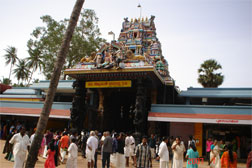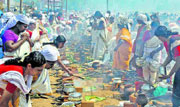The Attukal Bhagavathy Temple,
one of the ancient temples of South India, is popularly
described as Sabarimala of the Women, as women form the
major portion of devotees. The Goddess in the temple of
Attukal is worshipped as the Supreme Mother, creator of all
living beings and the mighty preserver as well as destroyer
of them all. The pilgrims from all over the country, who
visit Sree Padmanabha Swamy Temple and worship the Lord, do
not consider their visits complete without the visit to the
shrine of the supreme Mother Attukalamma. Vishnumaya took
the incarnation of Bhagavathy to annihilate the evil and
protect the good in the world in the present Era namely
Kaliyuga.
According to mythology, Attukal
Bhagavathy is supposed to be the divinised form of Kannaki,
the famous heroine of Chilapathikaram, written by
Elenkovadikal, the Tamil Poet. The story goes that after the
destruction of ancient city of Madurai, Kannaki left the
city and reached Kerala via Kanyakumari and on the way to
Kodungalloor took a sojourn at Attukal. Kannaki is supposed
to be the incarnation of Parvathy, the consort of Paramasiva.
The all powerful and benign Attukal Bhagavathy reigns
eternally supreme at Attukal and nurses devotees as a mother
does her children. Thousands of devotees from far and near
flock to the Temple to bend before the Goddess with awe and
reverence to prostrate and redress their affliction and
agony.
The Pongala Mahotsavam is the most
important festival of Attukal Bhagavathy Temple. The
offering of Pongala is a special temple practice prevalent
in the southern part of Kerala and some parts of Tamilnadu.
It is a ten-day programme commencing on the Karthika star of
the Malayalam month of Makaram-Kumbham (February-March) and
closing with the sacrificial offering known as
Kuruthitharpanam at night. On the ninth day of the festival
the world famous Attukal Pongala Mahotsavam takes place. The
entire area of about 5 kilometre radius around temple with
premises of houses of people of all caste, creed and
religion, open fields, roads, commercial institutions,
premises of Government offices etc. emerges as a consecrated
ground for observing Pongala rituals for lakhs of women
devotees assembling from different parts of Kerala and
outside. The ceremony is exclusively confined to women folk
and the enormous crowd, which gathers in Thiruvananthapuram
on this auspicious day is reminiscent of the Kumbhamela
Festival of North India.
Incarnation
of Goddess
India has ever been the holy land of
gods and goddesses. Since ages past, men and women kings and
emperors, saints and sages here were worshipping the Lord
not only as the omnipotent and absolute 'one' but also as
the 'one' whose manifestations are varied and manifold and
who possesses different names, forms and divine attributes.
Thus Almighty the Eternal God was worshipped in different
forms such as Brahma, Vishnu and Siva, and their consorts;
representing specific divine attributes of the Lord. Ancient
puranas have described that Siva and Sakthi were
simultaneously worshipped from the period of Aryans and
Dravidians. Vishnumaya took the incarnation of Bhagavathy to
annihilate evil and protect the good in this world. She
grants every wish of Her devotees and resides in their
hearts in multifarious forms.
Story of
Kannaki
According to mythology, Attukal
Bhagavathy is supposed to be the divinised form of "Kannaki",
the famous heroine of Chilappatikaram, the sangham work of
Tamil Literature written by ilamkovadikal. After the
destruction of the ancient city of Madurai, Kannaki left
that city and reached Kerala via Kanyakumari and on her way
to Kodungalloor took a sojourn at Attukal. The hymns of the
"Thottampattu ) sung during the annual temple festival, are
based on the story of Kannaki. Moreover, architectural
depictions of Goddess Kannaki seen on the Gopuram temple
substantiate this mythology. Small wonder then. that, Sri.
Vidyadhiraja Chattambi Swamy, the well known saint of Kerala,
found this temple premises ideal for his meditations. And
there are so many stories which prove the greatness of the
Goddess and which attract thousands of devotees to the
temple.
Aesthetics
of Architecture
Anyone visiting the Attukal temple is
first struck by the beauty and charm of the temple
architecture. The temple structure is a harmonious
conglomeration of both Kerala and Tamil styles of
architecture. The beautifully carved figures of
Mahishasuramarddini, Goddess Kali, Rajarajeswari, Sree
Parvathy with Lord Paramasiva and various other depictions
of the Goddess in and around the temple are undoubtedly the
work of a gifted artist. Equally well presented around the
corridors surrounding the temple, are the depiction of
various other Gods and the epic stories of the ten
incarnations of Lord Vishnu viz., the "Desavathara". On
either side of the elegant front gopura - are the icons
based on the story of Goddess Kannaki. On the southern
Gopura, the puranic story of "Dakshayaga" is depicted in
sculptures. The decorated gate at the entrance of the temple
is by itself an excellent example of architectural beauty.
There are two idols of the Goddess in the sanctum sanctorum.
The original idol is preserved in all its pristine beauty
covered in ornamental gold embedded with installed stones.
The second idol of the Goddess is installed besides the
original one. Within the temple corridors are also installed
carvings and sculptures of Lord Ganesan, the serpent God and
Lord Shiva. At the centre of the Sanctum within the
Sreekovil, at a consecrated spot is installed the idol of
the Goddess Attukal Bhagavathy emanating light and lustre to
all.





 The Pongala Mahotsavam is the most
important festival of Attukal Bhagavathy Temple, Trivandrum, Kerala. The offering of Pongala
is a special temple practice prevalent in the southern part of Kerala
and some parts of Tamilnadu. It is a ten-day programme commencing on the
Karthika star of the Malayalam month of Makaram-Kumbham (February-March)
and closing with the sacrificial offering known as Kuruthitharpanam at
night. On the ninth day of the festival the world famous Attukal Pongala
Mahotsavam takes place. The entire area of about 5 kilometre radius
around temple with premises of houses of people of all caste, creed and
religion, open fields, roads, commercial institutions, premises of
Government offices etc. emerges as a consecrated ground for observing
Pongala rituals for lakhs of women devotees assembling from different
parts of Kerala and outside. The ceremony is exclusively confined to
women folk and the enormous crowd, which gathers in Thiruvananthapuram
on this auspicious day is reminiscent of the Kumbhamela Festival of
North India.
The Pongala Mahotsavam is the most
important festival of Attukal Bhagavathy Temple, Trivandrum, Kerala. The offering of Pongala
is a special temple practice prevalent in the southern part of Kerala
and some parts of Tamilnadu. It is a ten-day programme commencing on the
Karthika star of the Malayalam month of Makaram-Kumbham (February-March)
and closing with the sacrificial offering known as Kuruthitharpanam at
night. On the ninth day of the festival the world famous Attukal Pongala
Mahotsavam takes place. The entire area of about 5 kilometre radius
around temple with premises of houses of people of all caste, creed and
religion, open fields, roads, commercial institutions, premises of
Government offices etc. emerges as a consecrated ground for observing
Pongala rituals for lakhs of women devotees assembling from different
parts of Kerala and outside. The ceremony is exclusively confined to
women folk and the enormous crowd, which gathers in Thiruvananthapuram
on this auspicious day is reminiscent of the Kumbhamela Festival of
North India.